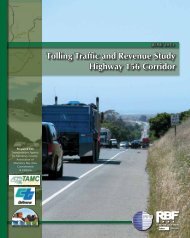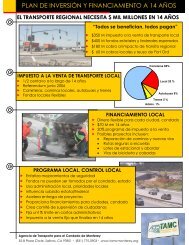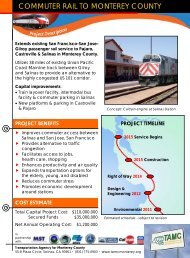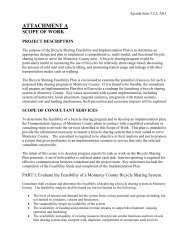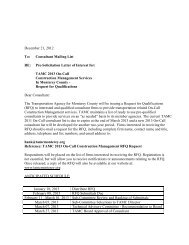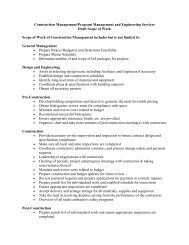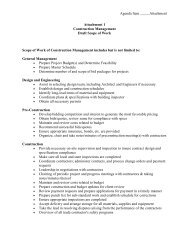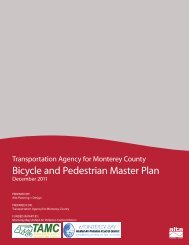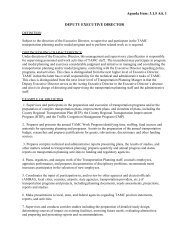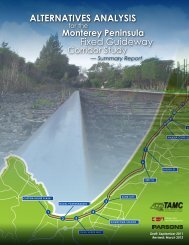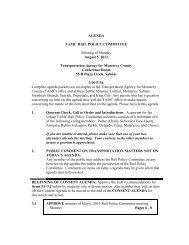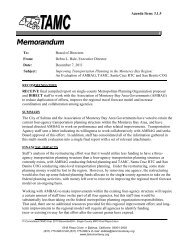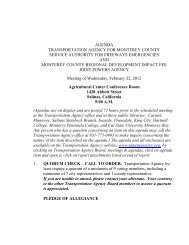CALTRAIN EXTENSION TO MONTEREY COUNTYALTERNATIVES ANALYSIS6. Is funding available to implement the proposed transit service?Table 7 lists the proposed capital budget for the Caltrain <strong>Extension</strong> to Monterey County project.The total estimated project cost is $99.5 million expressed in year-of-expenditure dollars,including a layover facility, bus transfer center, and commuter parking in Salinas, a platform andparking in Castroville, a platform and parking in Pajaro, and main line Union Pacific trackupgrades in Gilroy and between Gilroy and Salinas. The budget does not include an allowance forCaltrain rolling stock as sufficient passenger capacity exists to implement the two-train and fourtrainscenarios without need for additional passenger coaches.Funding for the Caltrain <strong>Extension</strong> project includes the State Traffic Congestion Relief Program,Proposition 116 rail bond funds, State <strong>Transportation</strong> Improvement Program–Public <strong>Transportation</strong>Account funds, Regional Surface <strong>Transportation</strong> Program-Interest, a federal earmark, CongestionMitigation and Air Quality Improvement funding, and contributions from local partneragencies. A proposed application for FTA New Starts funding in the amount of $45.0 million fillsthe gap between the available funding and the estimated total project cost. These fund sourcesand amounts are preliminary and are subject to change.Three sources of funds required to meet net public operating costs (subsidize transit operationsand maintenance expenses) are anticipated: Local <strong>Transportation</strong> funds, State Transit Assistancefunds, and local sales tax funds. 1Table 7Caltrain <strong>Extension</strong> to Monterey County Capital Budget—Funding Element(year of expenditure dollars)Funding SourcesIdentified FundsAvailable Secured Proposed Grand TotalRegional Surface <strong>Transportation</strong> Program–Interest $ 315,000 $ 315,000 $ 0 $ 315,000Federal earmark $ 990,644 $ 990,644 $ 0 $ 990,644Congestion Mitigation and Air Quality Improvement $ 975,000 $ 975,000 $ 0 $ 975,000Proposition 116 rail bond funds $ 3,000,000 $ 3,000,000 $ 0 $ 3,000,000State <strong>Transportation</strong> Improvement Program $ 4,520,000 $ 4,520,000 $ 0 $ 4,520,000Traffic Congestion Relief Program $ 20,000,000 $20,000,000 $ 0 $ 20,000,000Local contributions $ 16,865,000 $ 1,165,000 $15,700,000 $ 16,865,000Monterey–Salinas Transit Federal grant/local match $ 9,411,000 $ 0 $ 9,411,000 $ 9,411,000Federal New Starts $ 45,000,200 $ 0 $45,000,200 $ 45,000,200Total Revenues $101,076,844 $30,965,644 $70,111,200 $101,076,844Source: TAMC—subject to changePARTNERSHIPS AND COLLABORATIONThere is strong local support for the proposed service extension due to the projected populationgrowth in the Monterey Bay Area and the increasing numbers of San Francisco Bay Area workerswho are making their homes in San Benito, Santa Cruz, and Monterey counties. A multi-agency taskforce comprised of the Santa Clara Valley <strong>Transportation</strong> Authority, <strong>Transportation</strong> Agency forMonterey County, Association of Monterey Bay Area Governments, MST, Caltrans, Santa Cruz1 A local transportation sales tax is proposed as a November 2008 ballot initiative.parsons EXECUTIVE SUMMARY ES-11
CALTRAIN EXTENSION TO MONTEREY COUNTYALTERNATIVES ANALYSISCounty Regional <strong>Transportation</strong> Commission, San Benito County, and the cities of Salinas andWatsonville has been meeting to discuss and plan the initial steps to creating this train serviceextension. This project is an outgrowth of their multi-agency coordination.Local and regional agencies representing the study area or portions thereof have conducted manystudies that serve as precursors or complements to this selection of a locally preferred alternative.The project has been coordinated with the Union Pacific <strong>Rail</strong>road, the Peninsula Corridor JointPowers Board, Caltrans, the Santa Clara Valley <strong>Transportation</strong> Authority, the City of Salinas, theRedevelopment Agency of Monterey County, Monterey–Salinas Transit, the City of Watsonville, theSanta Cruz County Regional <strong>Transportation</strong> Commission, and the Santa Cruz Metropolitan TransitDistrict.Specific ongoing efforts include the City of Salinas’ plans for intensified transit-oriented developmentnear the Salinas station site, Caltrans’ plans for upgrading SR 156 east of Castroville Boulevard, theCastroville Community Plan, the Pajaro Community Plan, Union Pacific’s short- and long-term plansfor freight and yard operations, and the California Passenger <strong>Rail</strong> System Five-Year ImprovementPlan.SELECTION OF THE LOCALLY PREFERRED ALTERNATIVEThe results of this <strong>Alternatives</strong> <strong>Analysis</strong> study indicate that the Caltrain <strong>Extension</strong> to MontereyCounty is the most cost-effective alternative for serving inter-county commuters to SiliconValley and providing access to educational and health care resources in the San FranciscoBay Area. Selection of this option will meet the purpose and need of the proposed investment by providingadditional transportation capacity in the U.S. 101 travel corridor. Further, selection of the Caltrain<strong>Extension</strong> modal option can increase capacity over and above that defined for the Caltrain<strong>Extension</strong> Alternative by increasing the length of the trains and/or increasing the number of trains.The Caltrain <strong>Extension</strong> Alternative is also superior to the Express Bus Alternative for stimulating thelocal economy and supporting transit-oriented development.For the purpose of evaluating project worthiness, the Federal Transit Administration requires thatproject applicants for federal “New Starts” discretionary funding provide comparative information on aExpress Bus or “best bus” alternative. For this reason, performance characteristics of a “baseline”alternative have been included in this study along with those of the Caltrain <strong>Extension</strong> Alternative andthe minimum operating segment of the Caltrain <strong>Extension</strong> Alternative.Based on the array of technical information, evaluation findings and public input, a key outcome ofthe detailed <strong>Alternatives</strong> <strong>Analysis</strong> is the selection of a preferred long-term strategy for the corridor.The long-term strategy is defined as investments required to address the 2030 planning horizon. As asubcomponent of the locally preferred alternative, a reduced scope alternative is defined to addressnear term, opening year needs. This reduced scope alternative is known as the “minimum operatingsegment.” The minimum operating segment must address the purpose and need for the project withinthe context of near-term demographic and travel conditions. For the purpose of this study, the neartermminimum operating segment is defined for 2010 conditions.Three stations would initially be constructed as proposed for the full Caltrain <strong>Extension</strong> Alternative.Parking supplies would be reduced, however, commensurate with ridership expectations for the2010–2015 initial years of service operation. Other aspects of the minimum operating segment wouldbe as defined for the full Caltrain <strong>Extension</strong> Alternative.parsons EXECUTIVE SUMMARY ES-12
- Page 4 and 5: DRAFTCALTRAIN EXTENSIONTO MONTEREY
- Page 6 and 7: CALTRAIN EXTENSION TO MONTEREY COUN
- Page 8 and 9: CALTRAIN EXTENSION TO MONTEREY COUN
- Page 10 and 11: CALTRAIN EXTENSION TO MONTEREY COUN
- Page 12 and 13: CALTRAIN EXTENSION TO MONTEREY COUN
- Page 14 and 15: CALTRAIN EXTENSION TO MONTEREY COUN
- Page 16 and 17: CALTRAIN EXTENSION TO MONTEREY COUN
- Page 18 and 19: CALTRAIN EXTENSION TO MONTEREY COUN
- Page 20 and 21: CALTRAIN EXTENSION TO MONTEREY COUN
- Page 22 and 23: CALTRAIN EXTENSION TO MONTEREY COUN
- Page 24 and 25: CALTRAIN EXTENSION TO MONTEREY COUN
- Page 26 and 27: CALTRAIN EXTENSION TO MONTEREY COUN
- Page 28 and 29: CALTRAIN EXTENSION TO MONTEREY COUN
- Page 30 and 31: CALTRAIN EXTENSION TO MONTEREY COUN
- Page 34 and 35: CALTRAIN EXTENSION TO MONTEREY COUN
- Page 36 and 37: CALTRAIN EXTENSION TO MONTEREY COUN
- Page 38 and 39: CALTRAIN EXTENSION TO MONTEREY COUN
- Page 40 and 41: CALTRAIN EXTENSION TO MONTEREY COUN
- Page 42 and 43: CALTRAIN EXTENSION TO MONTEREY COUN
- Page 44 and 45: CALTRAIN EXTENSION TO MONTEREY COUN
- Page 46 and 47: CALTRAIN EXTENSION TO MONTEREY COUN
- Page 48 and 49: CALTRAIN EXTENSION TO MONTEREY COUN
- Page 50 and 51: CALTRAIN EXTENSION TO MONTEREY COUN
- Page 52 and 53: CALTRAIN EXTENSION TO MONTEREY COUN
- Page 54 and 55: CALTRAIN EXTENSION TO MONTEREY COUN
- Page 56 and 57: CALTRAIN EXTENSION TO MONTEREY COUN
- Page 58 and 59: CALTRAIN EXTENSION TO MONTEREY COUN
- Page 60 and 61: CALTRAIN EXTENSION TO MONTEREY COUN
- Page 62 and 63: CALTRAIN EXTENSION TO MONTEREY COUN
- Page 64 and 65: CALTRAIN EXTENSION TO MONTEREY COUN
- Page 66 and 67: CALTRAIN EXTENSION TO MONTEREY COUN
- Page 68 and 69: CALTRAIN EXTENSION TO MONTEREY COUN
- Page 70 and 71: CALTRAIN EXTENSION TO MONTEREY COUN
- Page 72 and 73: CALTRAIN EXTENSION TO MONTEREY COUN
- Page 74 and 75: CALTRAIN EXTENSION TO MONTEREY COUN
- Page 76 and 77: CALTRAIN EXTENSION TO MONTEREY COUN
- Page 78 and 79: CALTRAIN EXTENSION TO MONTEREY COUN
- Page 80 and 81: CALTRAIN EXTENSION TO MONTEREY COUN
- Page 82 and 83:
CALTRAIN EXTENSION TO MONTEREY COUN
- Page 84 and 85:
CALTRAIN EXTENSION TO MONTEREY COUN
- Page 86 and 87:
CALTRAIN EXTENSION TO MONTEREY COUN
- Page 88 and 89:
CALTRAIN EXTENSION TO MONTEREY COUN
- Page 90 and 91:
CALTRAIN EXTENSION TO MONTEREY COUN
- Page 92 and 93:
CALTRAIN EXTENSION TO MONTEREY COUN
- Page 94 and 95:
CALTRAIN EXTENSION TO MONTEREY COUN
- Page 96 and 97:
CALTRAIN EXTENSION TO MONTEREY COUN
- Page 98 and 99:
CALTRAIN EXTENSION TO MONTEREY COUN
- Page 100 and 101:
CALTRAIN EXTENSION TO MONTEREY COUN
- Page 102 and 103:
CALTRAIN EXTENSION TO MONTEREY COUN
- Page 104 and 105:
CALTRAIN EXTENSION TO MONTEREY COUN
- Page 106 and 107:
CALTRAIN EXTENSION TO MONTEREY COUN
- Page 108 and 109:
CALTRAIN EXTENSION TO MONTEREY COUN
- Page 110 and 111:
CALTRAIN EXTENSION TO MONTEREY COUN
- Page 112 and 113:
CALTRAIN EXTENSION TO MONTEREY COUN
- Page 114 and 115:
CALTRAIN EXTENSION TO MONTEREY COUN
- Page 116 and 117:
CALTRAIN EXTENSION TO MONTEREY COUN
- Page 118 and 119:
CALTRAIN EXTENSION TO MONTEREY COUN
- Page 120 and 121:
CALTRAIN EXTENSION TO MONTEREY COUN
- Page 122 and 123:
CALTRAIN EXTENSION TO MONTEREY COUN
- Page 124 and 125:
CALTRAIN EXTENSION TO MONTEREY COUN
- Page 126 and 127:
CALTRAIN EXTENSION TO MONTEREY COUN
- Page 128 and 129:
CALTRAIN EXTENSION TO MONTEREY COUN
- Page 130 and 131:
CALTRAIN EXTENSION TO MONTEREY COUN
- Page 132 and 133:
CALTRAIN EXTENSION TO MONTEREY COUN
- Page 134 and 135:
CALTRAIN EXTENSION TO MONTEREY COUN
- Page 136 and 137:
CALTRAIN EXTENSION TO MONTEREY COUN
- Page 138 and 139:
CALTRAIN EXTENSION TO MONTEREY COUN
- Page 140 and 141:
CALTRAIN EXTENSION TO MONTEREY COUN
- Page 142 and 143:
CALTRAIN EXTENSION TO MONTEREY COUN
- Page 144 and 145:
CALTRAIN EXTENSION TO MONTEREY COUN
- Page 146 and 147:
CALTRAIN EXTENSION TO MONTEREY COUN
- Page 148 and 149:
CALTRAIN EXTENSION TO MONTEREY COUN
- Page 150 and 151:
CALTRAIN EXTENSION TO MONTEREY COUN
- Page 152 and 153:
CALTRAIN EXTENSION TO MONTEREY COUN
- Page 154 and 155:
CALTRAIN EXTENSION TO MONTEREY COUN
- Page 156 and 157:
CALTRAIN EXTENSION TO MONTEREY COUN
- Page 158 and 159:
CALTRAIN EXTENSION TO MONTEREY COUN
- Page 160 and 161:
CALTRAIN EXTENSION TO MONTEREY COUN
- Page 162 and 163:
CALTRAIN EXTENSION TO MONTEREY COUN
- Page 164 and 165:
CALTRAIN EXTENSION TO MONTEREY COUN
- Page 166 and 167:
CALTRAIN EXTENSION TO MONTEREY COUN
- Page 168 and 169:
CALTRAIN EXTENSION TO MONTEREY COUN
- Page 170 and 171:
CALTRAIN EXTENSION TO MONTEREY COUN
- Page 172 and 173:
CALTRAIN EXTENSION TO MONTEREY COUN
- Page 174 and 175:
CALTRAIN EXTENSION TO MONTEREY COUN
- Page 176 and 177:
CALTRAIN EXTENSION TO MONTEREY COUN
- Page 178 and 179:
CALTRAIN EXTENSION TO MONTEREY COUN
- Page 180 and 181:
CALTRAIN EXTENSION TO MONTEREY COUN
- Page 182 and 183:
CALTRAIN EXTENSION TO MONTEREY COUN
- Page 184 and 185:
CALTRAIN EXTENSION TO MONTEREY COUN
- Page 186 and 187:
CALTRAIN EXTENSION TO MONTEREY COUN
- Page 188 and 189:
CALTRAIN EXTENSION TO MONTEREY COUN
- Page 190 and 191:
CALTRAIN EXTENSION TO MONTEREY COUN
- Page 192 and 193:
CALTRAIN EXTENSION TO MONTEREY COUN
- Page 194 and 195:
CALTRAIN EXTENSION TO MONTEREY COUN
- Page 196 and 197:
CALTRAIN EXTENSION TO MONTEREY COUN
- Page 198 and 199:
CALTRAIN EXTENSION TO MONTEREY COUN
- Page 200 and 201:
CALTRAIN EXTENSION TO MONTEREY COUN
- Page 202 and 203:
CALTRAIN EXTENSION TO MONTEREY COUN
- Page 204 and 205:
CALTRAIN EXTENSION TO MONTEREY COUN
- Page 206 and 207:
CALTRAIN EXTENSION TO MONTEREY COUN
- Page 208 and 209:
CALTRAIN EXTENSION TO MONTEREY COUN
- Page 210 and 211:
CALTRAIN EXTENSION TO MONTEREY COUN
- Page 212 and 213:
CALTRAIN EXTENSION TO MONTEREY COUN
- Page 214 and 215:
CALTRAIN EXTENSION TO MONTEREY COUN
- Page 216 and 217:
CALTRAIN EXTENSION TO MONTEREY COUN
- Page 218 and 219:
CALTRAIN EXTENSION TO MONTEREY COUN
- Page 220 and 221:
CALTRAIN EXTENSION TO MONTEREY COUN
- Page 222 and 223:
CALTRAIN EXTENSION TO MONTEREY COUN
- Page 224 and 225:
CALTRAIN EXTENSION TO MONTEREY COUN
- Page 226 and 227:
CALTRAIN EXTENSION TO MONTEREY COUN
- Page 228 and 229:
CALTRAIN EXTENSION TO MONTEREY COUN
- Page 230 and 231:
CALTRAIN EXTENSION TO MONTEREY COUN
- Page 232 and 233:
CALTRAIN EXTENSION TO MONTEREY COUN
- Page 234 and 235:
CALTRAIN EXTENSION TO MONTEREY COUN
- Page 236 and 237:
CALTRAIN EXTENSION TO MONTEREY COUN
- Page 238 and 239:
CALTRAIN EXTENSION TO MONTEREY COUN
- Page 240 and 241:
CALTRAIN EXTENSION TO MONTEREY COUN
- Page 242 and 243:
CALTRAIN EXTENSION TO MONTEREY COUN
- Page 244 and 245:
CALTRAIN EXTENSION TO MONTEREY COUN
- Page 246 and 247:
CALTRAIN EXTENSION TO MONTEREY COUN
- Page 248 and 249:
CALTRAIN EXTENSION TO MONTEREY COUN
- Page 250 and 251:
CALTRAIN EXTENSION TO MONTEREY COUN
- Page 252 and 253:
CALTRAIN EXTENSION TO MONTEREY COUN
- Page 254 and 255:
CALTRAIN EXTENSION TO MONTEREY COUN
- Page 256 and 257:
CALTRAIN EXTENSION TO MONTEREY COUN
- Page 258 and 259:
CALTRAIN EXTENSION TO MONTEREY COUN
- Page 260 and 261:
CALTRAIN EXTENSION TO MONTEREY COUN
- Page 262 and 263:
CALTRAIN EXTENSION TO MONTEREY COUN
- Page 264 and 265:
CALTRAIN EXTENSION TO MONTEREY COUN



